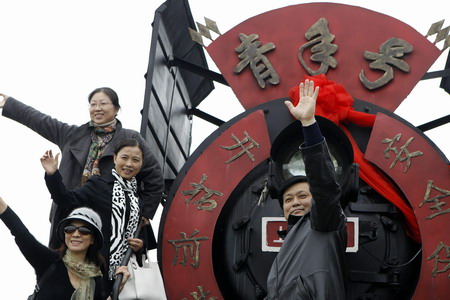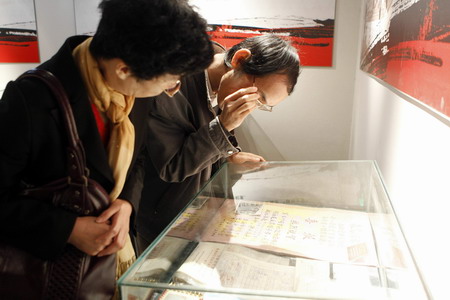Life and Leisure
Lost youth look back
By Xu Junqian (China Daily)
Updated: 2010-12-21 08:06
 |
Large Medium Small |
|
 Former zhiqing, or intellectual youths, gather around an old train, marked with the word "Youth" in Young Intellectuals' Square, in Shanghai. Photos by Yong Kai / China Daily |
A square set up in Shanghai to honor the young intellectuals sent to the countryside during the 'cultural revolution' sets off a wave of nostalgia. Xu Junqian reports
A whistle wails and youths depart from the cities aboard newly painted trains for remote villages. This was a familiar scene in the 1960s, when an estimated 17 million zhiqing, or intellectual youths, were sent to the countryside for reeducation by Chairman Mao Zedong, at the height of the "cultural revolution" (1966-1976).
Now, more than 40 years later, hundreds of middle-aged and gray-haired former "intellectual youths" from all over the country gather again at a square in Shanghai that's dedicated to them.
The Young Intellectuals' Square at Shanghai Haiwan Cemetery, one of two in the country (the other is in North China's Heilongjiang province) opened to the public in late November.
At the center of the 3,200-square-meter square in Shanghai is a museum, a wall filled with names and, in the central area, a two-coach dark green train, marked with the word "Youth" in white paint under the window of the driver's carriage.
The train, shipped from Inner Mongolia autonomous region at a cost of 3.7 million yuan ($550,000), including purchase and maintenance. It's an original train from the 1960s, though not one of the trains taken by young intellectuals, says Chen Yan, marketing manager of the square. In reality, young intellectuals could take any train fee of charge.
The square revives the bittersweet memories of China's "lost generation", who were then high school graduates, or graduates-to-be, and spent much of their youth toiling in the fields.
The nostalgic 50- and 60-year-olds are naturally drawn to the packed train, squeezing their heads out of the small square windows and waving. But this time, it isn't goodbye to their loved ones - it is a reunion. Cameras flash. Jokes are told.
"It's exactly like what happened all that time ago," says 58-year-old Qu Yuanmin, who was born in Shanghai and sent to Heilongjiang province at the age of 17. "I thought I had put all of this behind me, but it turned out the memories were all there. It was just like rubbing steam off a mirror."
At the back of the square, the 200-meter-long, 3-meter-high wall has 3,000 names written on the black marble at one end, representing the young intellectuals. At the other end are engraved pictures of them fishing, farming and felling trees.
Chen, the square manager, says the wall has helped many former young intellectuals bond once again with their erstwhile comrades, after they lost touch with them when there was a return to the cities at the end of the 1970s, after the "cultural revolution" concluded.
At the other side of the square is the museum, in which thousands of articles once used by, or related to, the young intellectuals have been collected. Largely donated by the young intellectuals, the collection has printed greeting letters from Chairman Mao, working tools, and a ship ticket from Shanghai to Anhui, priced at 5.70 yuan.
Founded by the owner of the cemetery, the stone dealer Yuan Yonglin from Zhejiang province, with an investment of 50 million yuan ($7.5 million), the square pays tribute to the resilience of the young intellectuals.
Even so, although some of the young intellectuals managed to catch up when the college entrance exam was restored in 1978, most lost out on their education and opportunities - hence, the term "lost youth".
"Many of the zhiqing are now living sub-standard lives either in their hometowns, or in the village they stayed in. Some are unemployed, others have low-income jobs like those of security guards or housemaids. And social welfare doesn't help much," says Wang Zhenxuan, a 62-year-old young intellectual from Shanghai, who says he is "a rare survivor in the competitive job market since the 1980s, because of the opening up and reform policy".
Wang's violin skills allowed him to shine in the village he was sent to in Guizhou province. He later became an art gallery director.
"I think it's good that more attention is being paid to us, which is sure to improve the life of zhiqing, both financially and mentally," Wang says, who has organized some remembrance events for his fellow young intellectuals.
In addition to the establishment of the square, Yuan Yonglin has also set up a fund of 2 million yuan to help former young intellectuals in financial straits. They can receive an allowance of 5,000 yuan a year, in addition to government handouts.
|
|
